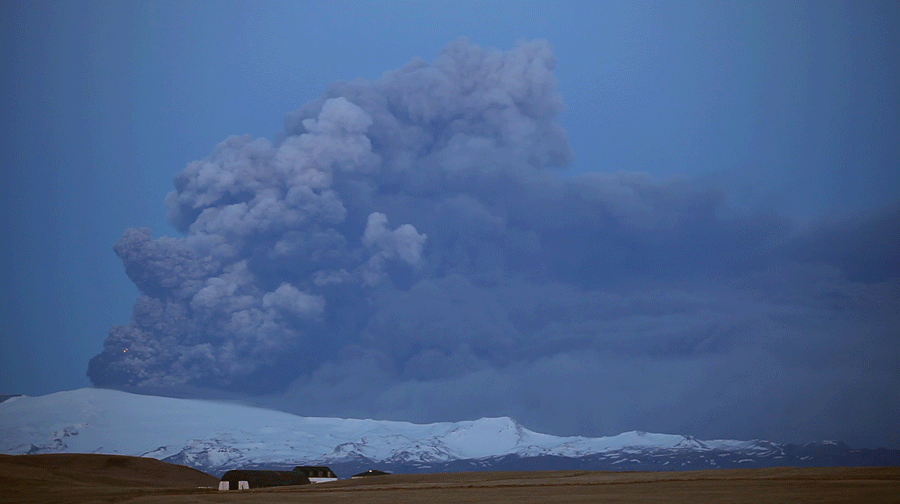A volcanic thunderstorm is a phenomenon similar to a regular thunderstorm that accompanies volcanic eruptions with emissions of large amounts of water vapor and ash. Scientists explain this by the interaction (friction) of positively charged particles of volcanic steam with negatively charged particles of ash.
The cause of regular lightning during a thunderstorm remains a subject of research, and the nature of volcanic lightning is even less understood. One hypothesis suggests that the ejected magma bubbles or volcanic ash carry an electric charge and that such separated areas arise as they move. However, volcanic lightning can also be caused by charge-generating collisions in volcanic dust.
A network of observation points established by researchers from the New Mexico Institute of Mining near the Redoubt volcano (Alaska) allowed scientists to detect two types of lightning that occur during an eruption, and they also managed to record electrical activity in the volcanic ash cloud with unprecedented resolution.
Observation points were equipped with ultra-short-wave radio detectors, and during the entire eruption, the researchers observed sixteen powerful storms, which allowed scientists to collect a huge amount of data for further research, during which it was discovered that volcanic lightning can be divided into two types – small (occurring near the crater itself) and powerful (high in the ash cloud). Currently, scientists tend to believe that both of these types of lightning have different natures.
The first type of volcanic lightning: is relatively small, occurring directly near the crater, and powerful, observed high in the ash cloud. Small low lightning is the result of electrical processes in magma when it is divided into many small particles.


Second type volcanic lightning: Large lightning in an ash cloud occurs when the temperature drops below -20 degrees Celsius, when supercooled water droplets freeze. Similar processes lead to discharges in clouds during thunderstorms. Scientists have also found a correlation between the height of the ash cloud and the power and frequency of lightning.
Not every eruption is accompanied by lightning. This means that the intensity of electrification of volcanic aerosol depends significantly on the characteristics of the eruption.
Volcanic aerosols are finely ground lava or drops of sulfuric acid containing solutions of sulfates, halides, traces of nickel and chromium.
Generally speaking, electrification of aerosol particles can occur for many reasons related to physical and physicochemical processes in a gas-ash cloud. However, given that the intensity of electrification of volcanic aerosol is significantly higher than that of all other known aerosols, it is probably possible to identify a number of specific processes that play a major role in the volcanic cloud.
The most significant features of volcanic aerosol are:
- Very high temperature;
- Large difference in temperature of solid aerosol particles both among themselves and in relation to the surrounding gas;
- Strong non-stationarity of volcanic ash particles, suspended in gas;
- Volcanic aerosol, unlike all others, includes ash, slag and even volcanic bombs.
* For reference [1]: Volcanic aerosol weakens the flow of solar radiation reaching the earth’s surface, which leads to some cooling of the climate. It should be noted that in the case of very strong volcanic eruptions (Penatubo in 1991, and St. Helena in 1981), the Earth’s climate changed significantly – a slight cooling occurred. And as a result of the most powerful eruption in human memory, the Tambora volcano in 1815 – in Europe and North America, the summer of 1816 was did not occur, which caused a great famine in Europe.

* For reference [2]:
Supervolcano is a volcano that produces the most powerful and voluminous eruptions (maximum 8 points on the VEI scale, mega-eruptions), throwing more than 1000 cubic kilometers of ash to a height of more than 25 kilometers. Subsequently, the volcano may periodically wake up, but erupt with less force. Over time, in place of the volcanic cone of a dormant supervolcano, after the collapse of its summit, a caldera is formed – a round depression in the form of a huge cauldron, up to several tens of kilometers in diameter, with fumaroles and hot water springs.
Origin of the term:
The term “Supervolcano” is not strictly scientific. The concept was first used in 2000 in the popular science television program BBC called “Horizon” to refer to very powerful volcanic eruptions. Since 2003, eruptions that reach 8 on the Volcanic Explosive Index (VEI) scale are sometimes classified by volcanologists as “super-eruptions” (igneous provinces and massive eruptions). The term “megacaldera” is sometimes used to refer to large calderas and craters, such as the Blake River Caldera in the Abitibe Belt of Ontario and Quebec in Canada.
List of the most famous supervolcanoes:
- Toba Caldera, Indonesia, Sumatra Island. Dimensions – 30 by 100 kilometers. The volume of the last eruption of this volcano, which occurred about seventy thousand years ago, reached 2500-3000 cubic kilometers of volcanic matter.
- Yellowstone Caldera is located in North America, was formed by an eruption of 1000 km3, 640 thousand years ago. 55 x 75 km.
- Long Valley Caldera is located in the state of California. Its size is 20 x 35 km.
- Taupo Volcano on the North Island of New Zealand. The crater lake is 46 km long and 33 km wide. An 8-point eruption occurred 24 thousand years ago.
- Valles Caldera in New Mexico. 19 x 22 km.
- Aira Caldera in Japan. 17 x 23 km.

Source: Project ALP





